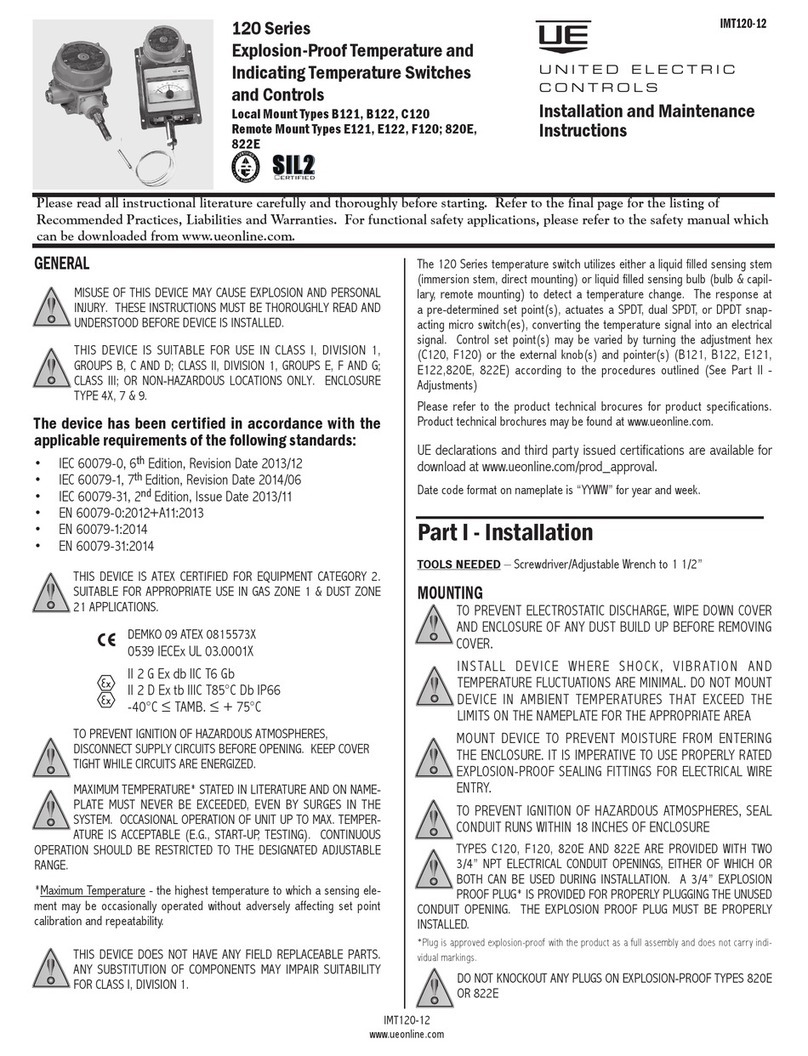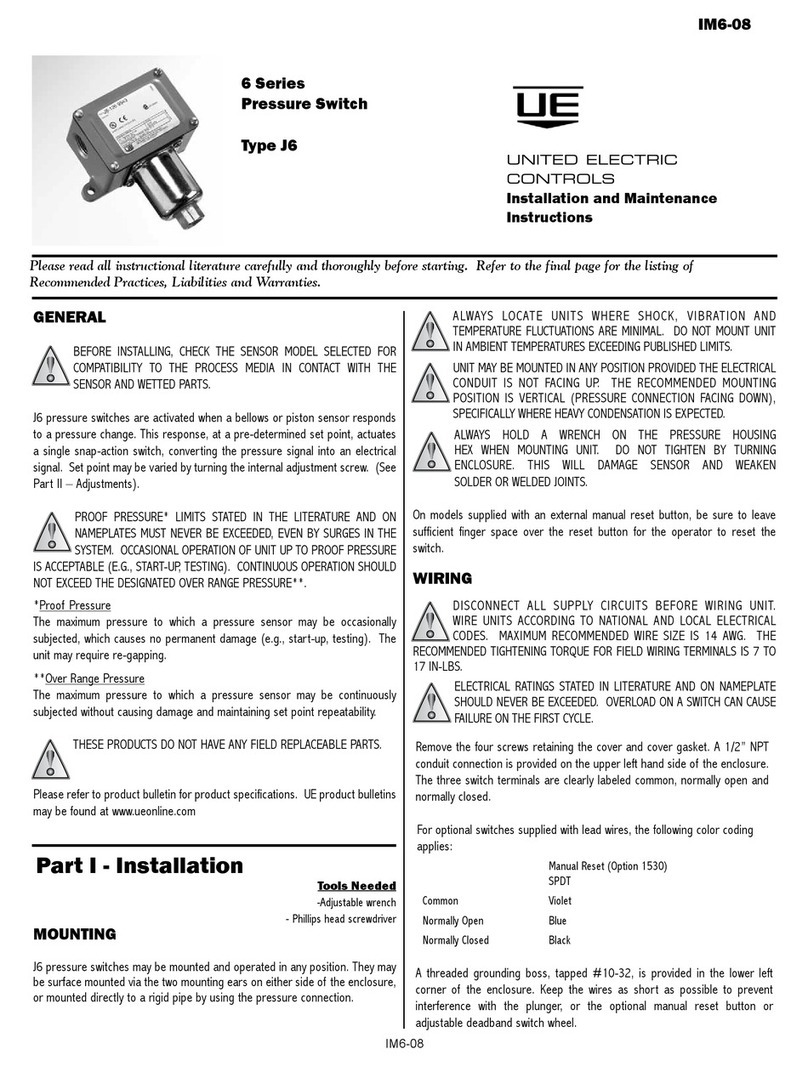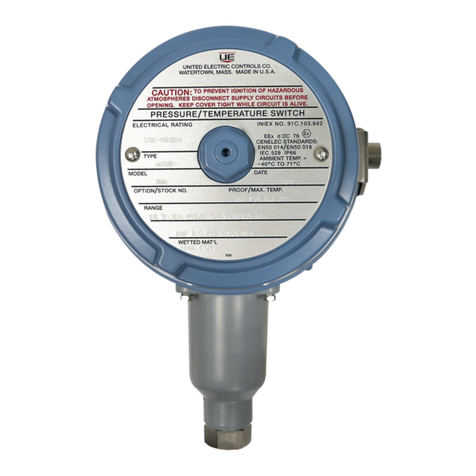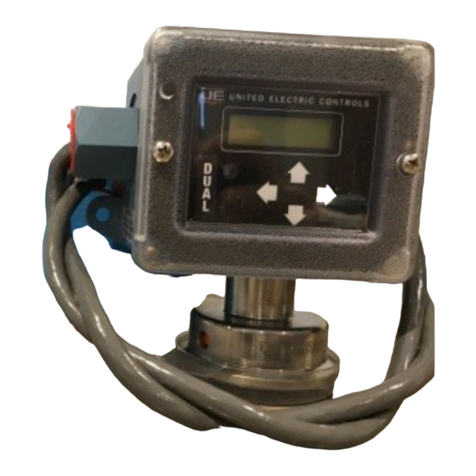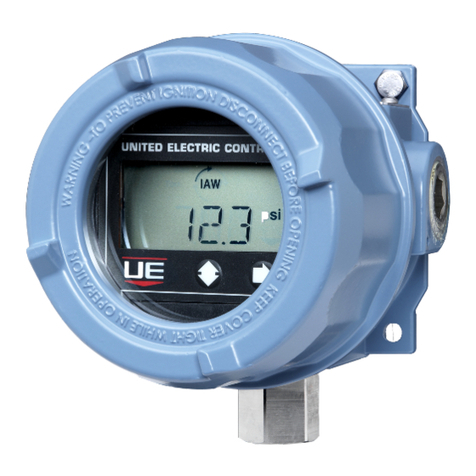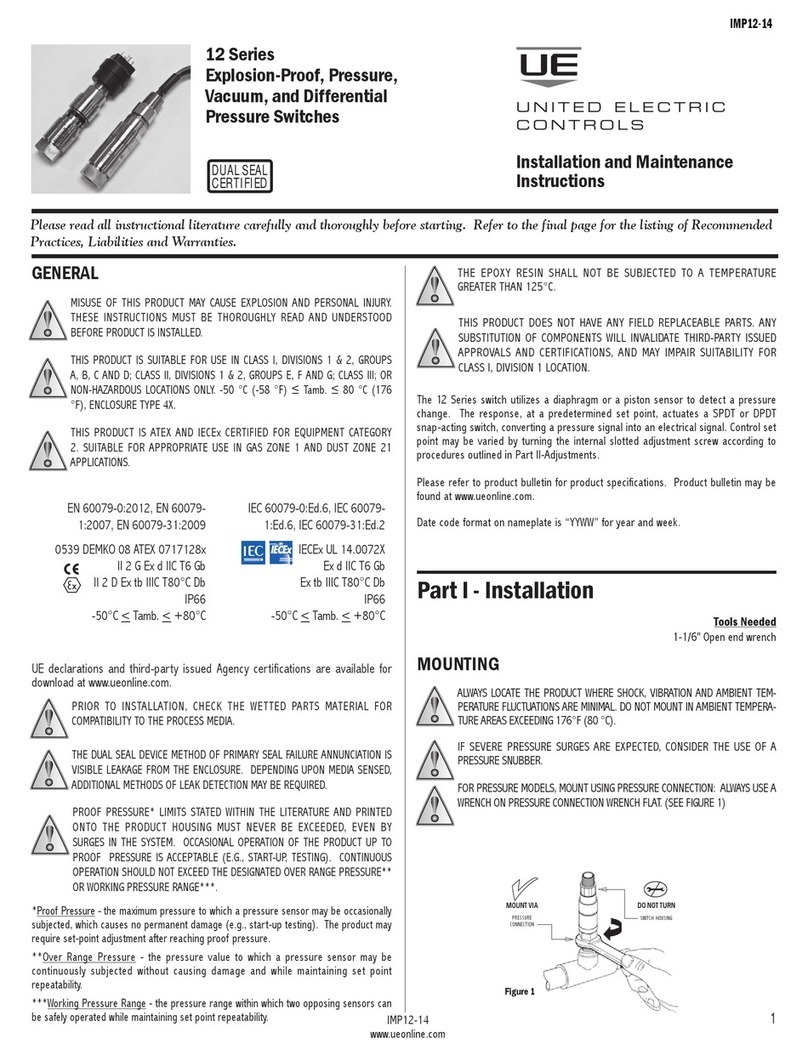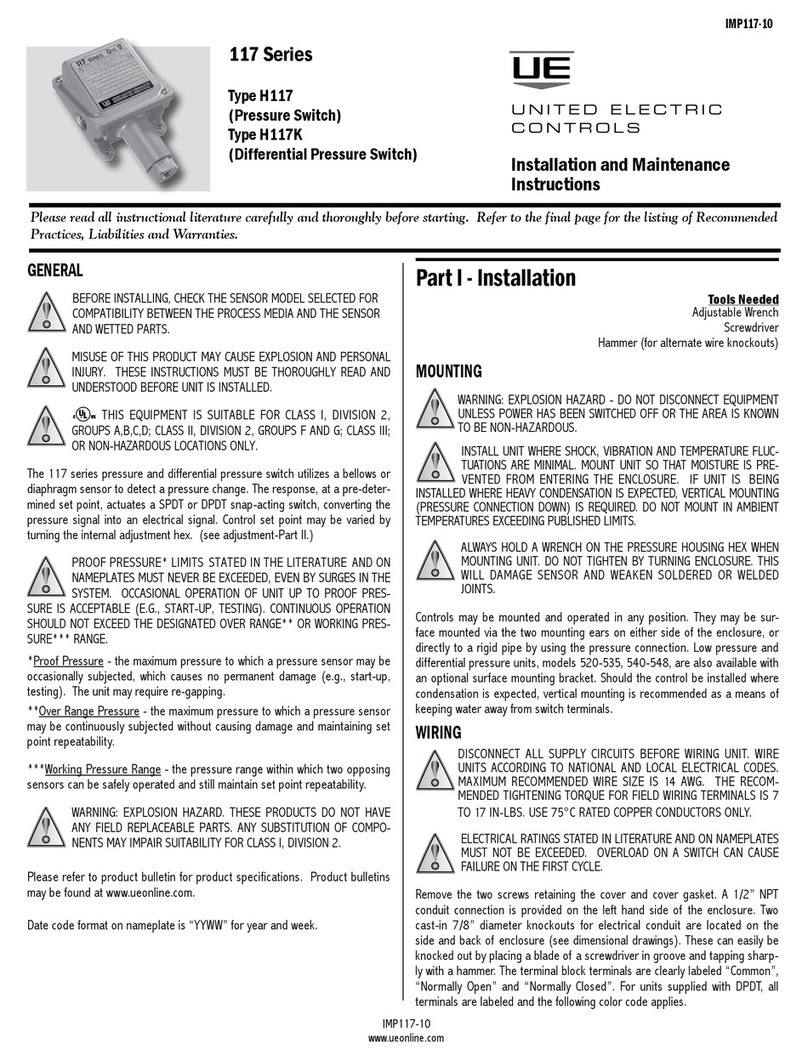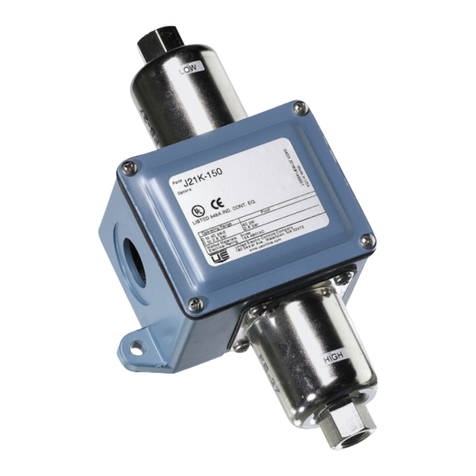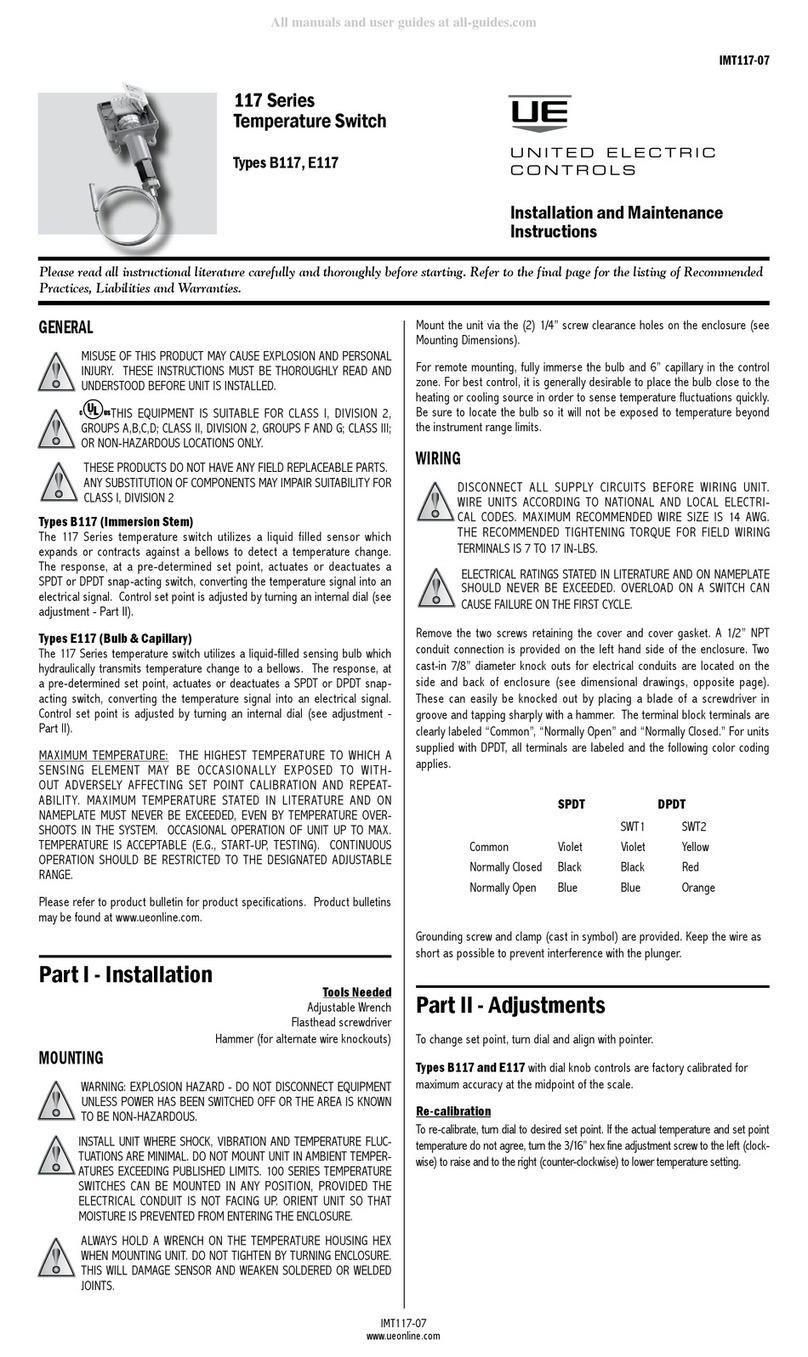
IM_1XSW-02
www.ueonline.com 1
GENERAL
MISUSE OF THIS PRODUCT MAY CAUSE EXPLOSION AND PERSONAL INJURY. THESE INSTRUCTIONS MUST BE THOROUGHLY READ AND UNDERSTOOD
BEFORE UNIT IS INSTALLED. SEE THE PRODUCT NAMEPLATE INFORMATION FOR SPECIFIC AGENCY CERTIFICATIONS APPLICABLE TO YOUR PRODUCT.
SUBSTITUTION OF COMPONENTS MAY IMPAIR SUITABILITY FOR USE IN HAZARDOUS LOCATIONS. CABLE GLANDS USED MUST BE RATED FOR A MINIMUM
OF IP66 IN ORDER TO MAINTAIN THE SAME IP RATING.
FOR ZONE HAZARDOUS LOCATIONS, ALL CABLE ENTRY DEVICES SHALL BE CERTIFIED IN TYPE OF EXPLOSION PROTECTION FLAMEPROOF ENCLOSURE “d”
WITH AN IP66 RATING, SUITABLE FOR THE CONDITIONS OF USE AND CORRECTLY INSTALLED. IF CABLES AND CABLE GLANDS ARE NOT USED, A STOPPING
BOX SHALL BE PROVIDED WITHIN 2” OF THE ENCLOSURE. FLAMEPROOF JOINT AND GAP DETAILS ARE PROVIDED ON PAGE 2.
INSTALL UNITS WHERE SHOCK, VIBRATION AND TEMPERATURE FLUCTUATIONS ARE MINIMAL. ORIENT UNIT TO PREVENT MOISTURE FROM ENTERING
ENCLOSURE. USE PROPERLY RATED SEALING FITTINGS FOR ELECTRICAL WIRE ENTRY. DO NOT MOUNT UNIT IN AMBIENT TEMPERATURES EXCEEDING
PUBLISHED LIMITS. THIS IS ESPECIALLY CRITICAL FOR LOCAL MOUNT TEMPERATURE UNITS. USE OF A SHROUD IS RECOMMENDED WHERE DIRECT SUNLIGHT
AND RAIN MAY COME IN CONTACT WITH THE ENCLOSURE.
DURING INSTALLATION, MARK THE BOX NEXT TO EACH PROTECTION METHOD ON THE NAMEPLATE THAT APPLIES TO YOUR APPLICATION.
THIS EQUIPMENT IS CERTIFIED IN ACCORDANCE WITH THE REQUIREMENTS OF THE FOLLOWING APPLICABLE STANDARDS (SEE TABLE 1) AND
IS SUITABLE FOR USE IN NON-HAZARDOUS AND THE FOLLOWING HAZARDOUS LOCATIONS, AND IS ATEX AND IECEX CERTIFIED SUITABLE FOR
APPROPRIATE USE IN GAS AND DUST ZONE 1 APPLICATIONS.
N. America Europe International
Intrinsic Safety - Model 1XSWLL Only
Cert number: UL File E226592 DEMKO 09 ATEX 0813748X IECEx UL 08.0017X
Applicable Standards UL 913, UL-60079-0, UL 60079-11, CSA C22.2 No.
157-92, CSA C22.2 No. 60079-0:11, CSA C22.2 No.
60079-11:14
EN 60079-0:2012 + A11:2013
EN 60079-11:2012
IEC 60079-0:Ed.6(2011-06) +
Corr.1 (2012-01) + Corr.2 (2013-
12)
IEC 60079-11:Ed.2011
Suitable for appropri-
ate use in:
EXIA Intrinsically
Safe - Sécurité Intrin-
séque
Class I, Div. 1, Groups A, B, C & D
Class II, Div. 1 Groups E, F & G
Class III
Class I, Zone 0 AEx ia IIC T4
Ex ia IIC T4
II 1 G Ex ia IIC T4 Ga
II 1 D Ex ia IIIC T135°C Da
-40°C < TAMB < +85°C
Ex ia IIC T4 Ga
Ex ia IIIC T135°C Da
-40°C < TAMB < +85°C
Flameproof - Models 1XSWLL, 1XSWHL and 1XSWHH
Cert Number: UL File E226592 DEMKO 09 ATEX 0813748X IECEx UL 08.0017X
Applicable Standards UL 1203, UL 60079-0, UL 60079-1, UL 61010-1, UL
50, UL 50E, CSA C22.2 No. 25, CSA C22.2 No. 30, CSA
C22.2 No. 60079-0:11, CSA C22.2 No. 60079-1:11, CSA
C22.2 No. 61010-1-12, CSA C22.2 No. 94.01-07, CSA
C22.2 No. 94.2-07
EN 60079-0:2012 + A11:2013
EN 60079-1:2014
EN 60079-31:2014
IEC 60079-0:Ed.6(2011-06) +
Corr.1 (2012-01) + Corr.2 (2013-
12)
IEC 60079-1:Ed.7
IEC 60079-31:Ed.2
Suitable for appropri-
ate use in:
Class I, Div. 1, Groups A, B, C & D
Class II, Div. 1 Groups E, F & G
Class III
Class I, Zone 1 AEx db IIC T5 (1XSWLL)
Class I, Zone 1 Ex db IIC T5
Class I, Zone 1 AEx db IIC T3/T5 (1XSWHL & 1XSWHH)
II 2 G Ex db IIC T3/T5 Gb
II 2 D Ex tb IIIC T90°C Db
IP66
-40°C ≤ TAMB ≤ +85°C (1XSWLL)
-40°C ≤ TAMB ≤ +80°C (1XSWHL &
1XSWHH)
Ex db IIC T3/T5 Gb
Ex tb IIIC T90°C Db
IP66
-40°C ≤ TAMB ≤ +85°C (1XSWLL)
-40°C ≤ TAMB ≤ +80°C (1XSWHL
& 1XSWHH)
One Series
Electronic Pressure, Differential
Pressure and Temperature Switches
Discrete Input, Intrinsically Safe,
Flameproof and Non-Incendive
Models: 1XSWLL, 1XSWHL, and 1XSWHH
UNITED ELECTRIC
CONTROLS
Installation and Maintenance
Instructions
IM_1XSW-02
Please read all instructional literature carefully and thoroughly before starting. Refer to the final page for the listing of Recommended
Practices, Liabilities and Warranties. All Warnings are translated to French and can be found on pages 21 and 22.
